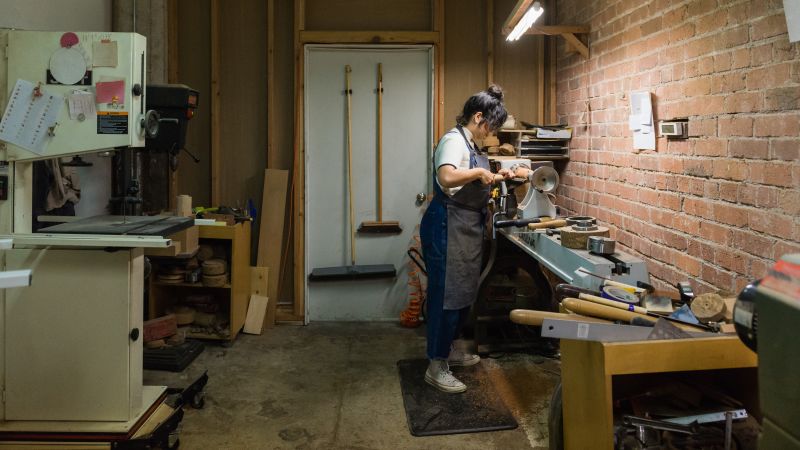Small enterprises play a crucial role in the American economy, often considered the backbone of various industries. Despite the rhetoric of support from figures such as President Donald Trump, whose “America First” trade policies are purportedly designed to bolster domestic businesses, many small business owners have found their hard work and aspirations unraveling. The imposition of tariffs has created a precarious environment, where optimism is often drowned by fear and uncertainty.
A poignant example of this is Katharine Burke, who celebrated the production of her self-care product line named Purryfuls during the first week of April. Yet, the same week brought debilitating tariffs on imported goods from China, where her products are manufactured. The unwelcome timing of these tariffs has forced Burke and countless others into a difficult predicament, where the costs of bringing their ideas to market have skyrocketed almost overnight.
Melanie Abrantes, who has spent over a decade establishing her handcrafted design company, now grapples with the unexpected costs of ordering more materials for her expanding subscription carving club. The ever-changing landscape of tariffs has produced sudden price increases on exotic materials sourced from countries like Japan and Portugal, which she meticulously integrates into her crafted designs. The uncertainty around tariffs hindered her planning and pricing decisions, making it increasingly challenging for her to sustain her business.
Beth Fynbo Benike, owner of Busy Baby, had anticipated a significant growth year in 2025 after clinching deals to supply her innovative baby products to major retailers. However, she now faces an immense hurdle; the costs for transporting her largest-ever inventory order have surged to nearly $230,000, thanks to the hefty tariffs. Benike’s story reflects a common theme among small businesses: an unexpected shift in the trade climate can set back years of progress without warning.
President Trump’s trade policies have, according to various accounts, wreaked havoc among small businesses, destabilizing supply chains that have long been in operation and hindering future growth plans. Businesses that once thrived on predictability now find themselves navigating an unpredictable landscape littered with hurdles and potential collapse due to the drastic tariff changes which have risen rapidly, often beyond their capacity to absorb.
“I’m fully leveraged against this,” said Benike, expressing her anxieties about potentially losing her home and her ability to provide for her children. Such sentiments reflect the acute sense of anxiety that many entrepreneurs experience as they watch their businesses face daunting financial challenges. Small firms often lack the cushion that larger corporations have, making them particularly vulnerable to external economic shocks.
Many small business owners, including Burke, have found themselves in a bind where manufacturing domestically has become nearly impossible due to the lack of available resources. Desiring to source materials locally, Burke set out to manufacture her products within the US but ultimately found it untenable. The historical investment in manufacturing capabilities overseas, particularly in China, means that transitioning back to domestic production is not feasible in the short term.
Economists have weighed in, cautioning that the recent tariff escalations could result in dire economic repercussions, including inflation, reduced consumer spending, and potential increases in unemployment. The stark reality is that the fate of small businesses may serve as a leading indicator of wider economic adversity, as these enterprises represent nearly half of the American workforce.
The escalating tariffs have prompted various small business leaders to reassess their strategies. Gus Faucher, chief economist at the PNC Financial Services Group, stated that small enterprises typically operate on tight margins with limited flexibility to absorb cost increases. Unlike larger organizations, they cannot dictate terms to suppliers, making them more fragile in the face of sudden changes in the market.
One telling account comes from Burke, who has invested two years into developing Purryfuls—a plushie designed to help Millennials and Gen Z cope with stress—and faces incoming tariffs that could significantly disrupt her planned launch. Her journey underscores the fragility of new enterprises that might be jeopardized by international trade policies, which fluctuate rapidly and unpredictably.
Similar struggles are being echoed by other small business owners. For instance, Melanie Abrantes remains deeply connected to her heritage through her work, but must now navigate rising costs that may undermine her ability to run her business. Despite her investment in ensuring high-quality, artisan products from abroad, she is at the mercy of shifting tariffs that threaten her unique marketplace positioning.
As these small businesses grapple with chaotic trade environments, many are beginning to explore alternatives. Some, like Busy Baby’s Benike, are even venturing into crowdfunding to mitigate the financial strain imposed by the tariffs. Such unexpected strategies highlight the lengths entrepreneurs will go to protect their dreams in a shifting economic terrain.
In the end, the stories shared speak volumes about the delicate balance that small businesses must strike; they are the lifeblood of American innovation and employment but remain vulnerable to the caprices of trade policies. Without additional support and a more stable trade environment, their ability to thrive—and in some cases, to survive—may be in jeopardy.



